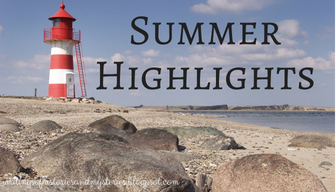International Christmas Traditions ~ Part 2
Last year, I did an article like this, but this is Part 2. Last time, I discussed the Christmas traditions of China, Bangladesh, Croatia, Egypt, and Madagascar. This year, I have several more countries I'm writing about.
"Happy Christmas" in Argentina
Because it is below the equator, Christmas occurs during the summer. This is true also for the countries of Australia, Bolivia, and Brazil. In Argentina, houses are decorated with lights, garlands, and wreaths of gold, red, green, and white flowers. Their Christmas tree is usually decorated by December 8th for the Feast of the Immaculate Conception, a Catholic holiday celebrating when Mary was conceived. Any tree may be used as a Christmas tree and sometimes white cotton balls are sprinkled on the tree to represent snow. Another common Christmas decoration is the Nativity scene, also called a pesebre. In Argentina, Christmas cards are not a common form of greeting.
Because Argentina is primarily a Catholic country, Christmas Eve is the most important day. On this day are masses in the afternoon, family dinner in the late evening (10 to 11 pm), and fireworks at midnight. An alternative to the fireworks is paper lantern called globos, that is released after midnight. Some people go to midnight services and others toast the arrival of Christmas Day. Some people choose to go home and open presents. Most people stay up all Christmas Eve and then sleep all of Christmas Day.
I'm not going to miss out on the food aspect of Christmas Eve dinner. Some of these dinners may be served in the garden (remember it is nearly midnight when this meal takes place) or may even be a barbecue. Roast turkey, roast pork, roast goat (more popular in the north of the country where the highlands are), stuffed tomatoes, salads, breads, and puddings such as Pan Dulce, and Panettone are typically eaten.
"Congratulations for the Holy Birth" in Armenia
The Armenian Apostolic Church celebrates Christmas and the Epiphany on June 6th. Epiphany refers to the moment when it was revealed that Jesus was God's son. I'm guessing that refers to Jesus' baptism since this event is also celebrated with the Epiphany. The coming of the wise men is also celebrated on the same day. That is four events to celebrate on the same day!
Some Armenians fast the whole week before Christmas until a dinner feast on Christmas Eve, called khetum. Rice, fish, nevik (green chards and chickpeas), tanabur (a soup made with wheat or yogurt), dried fruits, dried nuts, rojik (shelled walnuts threaded on a string and encased in grape jelly), and bastukh (another grape jelly dessert). The meal is meant to be very light to ease the stomach into eater heavier foods for Christmas dinner. At this meal, children receive fruits, nuts, and candies as presents. Other traditional foods include Anooshaboor (pudding) and Khozee bood (glazed ham). Each house is stocked with lots of treats because the Armenians will visit each other's houses to celebrate.
Santa Claus is also a part of Armenian culture; however, he comes on New Year's Eve in order to separate the Armenian culture from the American culture. In Republic Square in the capital of Armenia, Yerevan, a large Christmas tree is displayed from the beginning of December.
"Merry Christmas" in Australia
Because Australia has opposite season patterns than we do in America, Christmas is also in summer and during summer vacation from school. Because of the heat, there are often bush fires during the so-called "holiday season. Most people wouldn't expect Christmas in Australia to be much different from America besides this fact.
The Australian Christmas is quite similar in the decorations and the activities (except for the fact that some families choose to camp during Christmas just like one would do in the American summertime). In addition to normal Christmas decorations such as wreaths, the "Christmas Bush" serves as another decoration since its cream-colored flowers bloom red during December. Charity competitions for light displays are popular.
There is a large concert called "Carols by Candlelight" that features many of their famous singers and are broadcasted from cities all across Australia. Of course, because it is summer in Australia, they change the words of their carols to reflect their season instead of winter and snow. There are also large pageants in the capitals of each of their states/territories as well as festivals, parades, and fireworks displays.
In Australia, Santa Claus gives his reindeers a rest and instead uses "Six White Boomers" aka kangaroos. That is also the name of a Christmas song there. And of course, he also receives a change of summer clothes. The "Flying Doctor Service" transmits radio signals to citizens living on the outback, so they can wish each other a "Merry Christmas."
The main Christmas meal is eaten at lunchtime, and it may consist of either seafood or barbecue. Lobsters, prawns, and fish can be bought fresh from the markets that remain open on Christmas Eve. Christmas crackers are also another addition to their holiday meals. Two people would grab each side and pull. When the wrapper cracked or popped, one person would receive all of the candy in the middle. That sounds like a lot of fun to play with your siblings.
"Happy Christmas" in Argentina
Because it is below the equator, Christmas occurs during the summer. This is true also for the countries of Australia, Bolivia, and Brazil. In Argentina, houses are decorated with lights, garlands, and wreaths of gold, red, green, and white flowers. Their Christmas tree is usually decorated by December 8th for the Feast of the Immaculate Conception, a Catholic holiday celebrating when Mary was conceived. Any tree may be used as a Christmas tree and sometimes white cotton balls are sprinkled on the tree to represent snow. Another common Christmas decoration is the Nativity scene, also called a pesebre. In Argentina, Christmas cards are not a common form of greeting.
Because Argentina is primarily a Catholic country, Christmas Eve is the most important day. On this day are masses in the afternoon, family dinner in the late evening (10 to 11 pm), and fireworks at midnight. An alternative to the fireworks is paper lantern called globos, that is released after midnight. Some people go to midnight services and others toast the arrival of Christmas Day. Some people choose to go home and open presents. Most people stay up all Christmas Eve and then sleep all of Christmas Day.
 |
| Globos |
 |
| Panettone |
"Congratulations for the Holy Birth" in Armenia
The Armenian Apostolic Church celebrates Christmas and the Epiphany on June 6th. Epiphany refers to the moment when it was revealed that Jesus was God's son. I'm guessing that refers to Jesus' baptism since this event is also celebrated with the Epiphany. The coming of the wise men is also celebrated on the same day. That is four events to celebrate on the same day!
Some Armenians fast the whole week before Christmas until a dinner feast on Christmas Eve, called khetum. Rice, fish, nevik (green chards and chickpeas), tanabur (a soup made with wheat or yogurt), dried fruits, dried nuts, rojik (shelled walnuts threaded on a string and encased in grape jelly), and bastukh (another grape jelly dessert). The meal is meant to be very light to ease the stomach into eater heavier foods for Christmas dinner. At this meal, children receive fruits, nuts, and candies as presents. Other traditional foods include Anooshaboor (pudding) and Khozee bood (glazed ham). Each house is stocked with lots of treats because the Armenians will visit each other's houses to celebrate.
 |
| Anooshaboor (also spelled Anoush Abour) |
 |
| Nevik |
 |
| Rojik |
"Merry Christmas" in Australia
Because Australia has opposite season patterns than we do in America, Christmas is also in summer and during summer vacation from school. Because of the heat, there are often bush fires during the so-called "holiday season. Most people wouldn't expect Christmas in Australia to be much different from America besides this fact.
The Australian Christmas is quite similar in the decorations and the activities (except for the fact that some families choose to camp during Christmas just like one would do in the American summertime). In addition to normal Christmas decorations such as wreaths, the "Christmas Bush" serves as another decoration since its cream-colored flowers bloom red during December. Charity competitions for light displays are popular.
There is a large concert called "Carols by Candlelight" that features many of their famous singers and are broadcasted from cities all across Australia. Of course, because it is summer in Australia, they change the words of their carols to reflect their season instead of winter and snow. There are also large pageants in the capitals of each of their states/territories as well as festivals, parades, and fireworks displays.
 |
| Christmas crackers |
The main Christmas meal is eaten at lunchtime, and it may consist of either seafood or barbecue. Lobsters, prawns, and fish can be bought fresh from the markets that remain open on Christmas Eve. Christmas crackers are also another addition to their holiday meals. Two people would grab each side and pull. When the wrapper cracked or popped, one person would receive all of the candy in the middle. That sounds like a lot of fun to play with your siblings.
***
I hope you enjoyed learning about those cultures. Rest assured: if this blog continues until next December, there will certainly be more cultures in a Part 3. Last year, Triniti and Anna at TAJ News Blog posted two articles on the Christmas traditions of Israel (Triniti) and Germany (Anna). Go ahead and read those.
Today's quote of the week is from an American author: “Our hearts grow tender with childhood memories and love of kindred, and we are better throughout the year for having, in spirit, become a child again at Christmastime.” ~ Laura Ingalls Wilder



Comments
Post a Comment